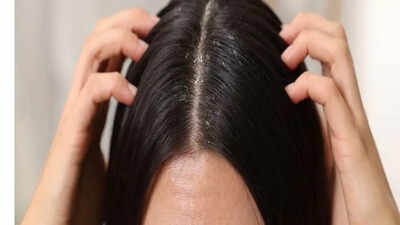Finding flakes in your hair or on your clothes? It's essential to determine whether you're experiencing dandruff or a dry scalp, as the causes and treatments for each condition vary significantly. While both conditions result in flaking and itching, dandruff is typically linked to excessive oil production and fungal overgrowth, while a dry scalp arises from a lack of moisture and harsh hair care practices. Understanding the underlying cause is essential for selecting the appropriate scalp treatment.

At first glance, dandruff and a flaky scalp may appear identical. However, a closer examination reveals distinct characteristics. Dandruff typically presents as yellowish or white flakes that tend to cling to the hair shaft. These flakes rarely detach on their own unless the hair is thoroughly brushed. In contrast, a dry scalp produces small, dry, white flakes that readily fall off, even without brushing. This condition closely resembles dry skin and the shedding of dead skin cells, particularly during the winter months.
If you notice white flakes on your shoulders, carefully inspect your scalp. Redness and oiliness, accompanied by persistent itching, are indicative of dandruff. Conversely, a dry, tight, and dehydrated scalp that itches intermittently suggests a flaky scalp.
The onset of dandruff is often associated with an oily scalp, dermatitis, or an overgrowth of yeast. These factors can be triggered by hormonal fluctuations, stress, excessive oil secretion, and infrequent scalp washing. A flaky scalp, on the other hand, typically results from dry skin, the use of harsh chemical-laden products, climate variations, and dehydration.
If you are unsure of your symptoms, using an anti-dandruff shampoo for a week is a good way to test. If you have dandruff, the anti-dandruff shampoo will help to reduce irritation. However, if the problem persists, it is most likely a flaky scalp, and you should switch to hydrating shampoo, oil your hair, and use products that are gentle on the scalp. Also, try to limit your use of heating equipment, as that would have an adverse effect on the flaky scalp. If the problem persists, seek the opinion of a dermatologist.
A dry scalp primarily stems from moisture depletion. Similar to dry skin on other areas of the body, the scalp can become flaky, rough, and tight when it lacks sufficient hydration.
Common contributing factors include:
If dehydration is the underlying cause, you may also notice dry skin on other parts of your body, such as your arms, legs, or face.
Dandruff is typically caused by seborrheic dermatitis, a condition that causes the scalp to become oily, red, and flaky. A 2018 study of Indian women's scalps revealed that dandruff is strongly linked to an overgrowth of a naturally occurring yeast called Malassezia, which thrives in oily environments. When this yeast multiplies excessively, it irritates the scalp and accelerates skin cell turnover, leading to the formation of white or yellow flakes.
Several factors can trigger or exacerbate dandruff:
In contrast to a dry scalp, dandruff is often a chronic, recurring problem that requires ongoing management.
Once you've pinpointed the underlying cause, treatment becomes more targeted and effective.
Accurately identifying the underlying issue is crucial for selecting the appropriate treatment for dandruff and dry scalp. While both conditions involve flaking, their root causes differ, ranging from oil and yeast overgrowth to dehydration and harsh products. First, pinpoint the cause, then adjust your hair care routine accordingly, and consult a dermatologist if symptoms persist.
Newer articles
Older articles
 Vitamin D Could Slash Tooth Decay Risk by 50%, Study Suggests
Vitamin D Could Slash Tooth Decay Risk by 50%, Study Suggests
 Indian Cricket Star Mukesh Kumar and Wife Divya Singh Announce Birth of Son
Indian Cricket Star Mukesh Kumar and Wife Divya Singh Announce Birth of Son
 Shubman Gill's Captaincy Under Fire: Bold Calls Needed After England Test Defeat
Shubman Gill's Captaincy Under Fire: Bold Calls Needed After England Test Defeat
 Microsoft Aims for Foldable Redemption with Novel Hinge Design to Rival iPhone and Android
Microsoft Aims for Foldable Redemption with Novel Hinge Design to Rival iPhone and Android
 Popular Finance YouTuber's Account Hacked, Bitcoin Scam Promoted: Security Lessons Learned
Popular Finance YouTuber's Account Hacked, Bitcoin Scam Promoted: Security Lessons Learned
 Esha Gupta Breaks Silence on Hardik Pandya Romance Rumors: 'We Were Just Talking'
Esha Gupta Breaks Silence on Hardik Pandya Romance Rumors: 'We Were Just Talking'
 Hollywood's Love Affair with India: Iconic Film Locations Revealed
Hollywood's Love Affair with India: Iconic Film Locations Revealed
 Rishabh Pant Aims to Surpass Virat Kohli in Test Century Tally During England Series
Rishabh Pant Aims to Surpass Virat Kohli in Test Century Tally During England Series
 Prithvi Shaw Credits Sachin Tendulkar's Guidance for Career Revival After Setbacks
Prithvi Shaw Credits Sachin Tendulkar's Guidance for Career Revival After Setbacks
 Ashada Gupt Navratri 2025: Unveiling Dates, Timings, Significance & Secret Rituals
Ashada Gupt Navratri 2025: Unveiling Dates, Timings, Significance & Secret Rituals